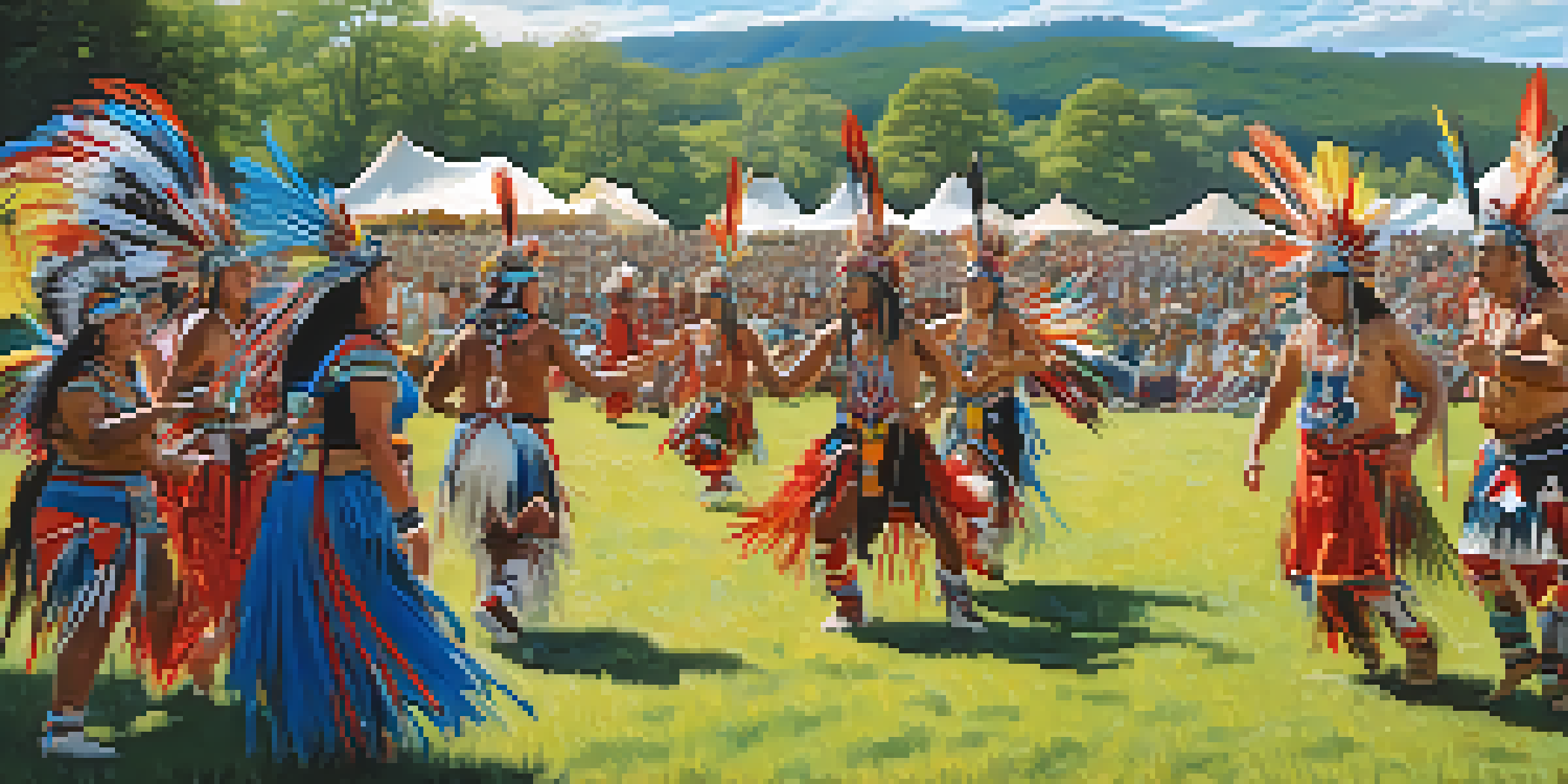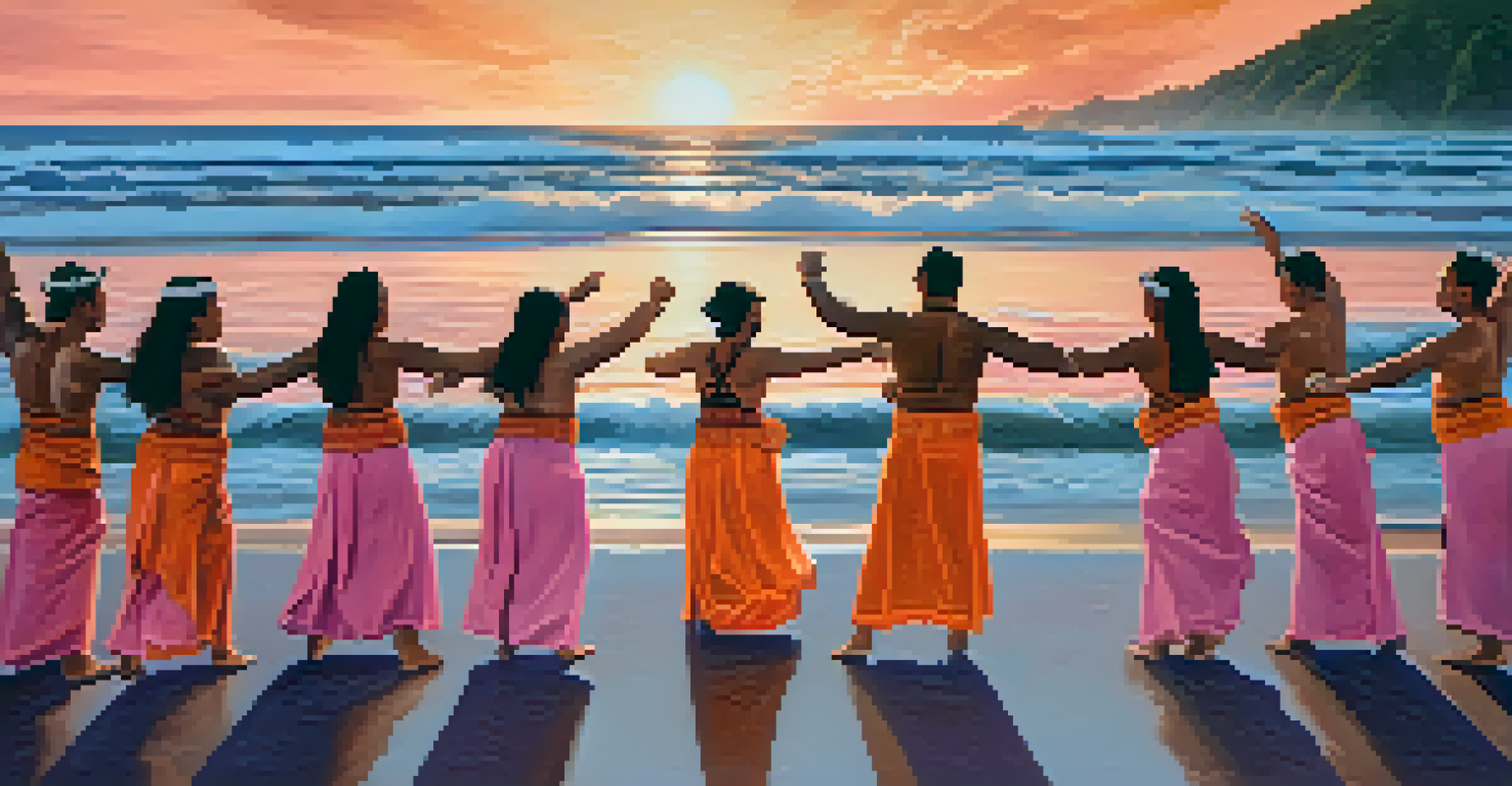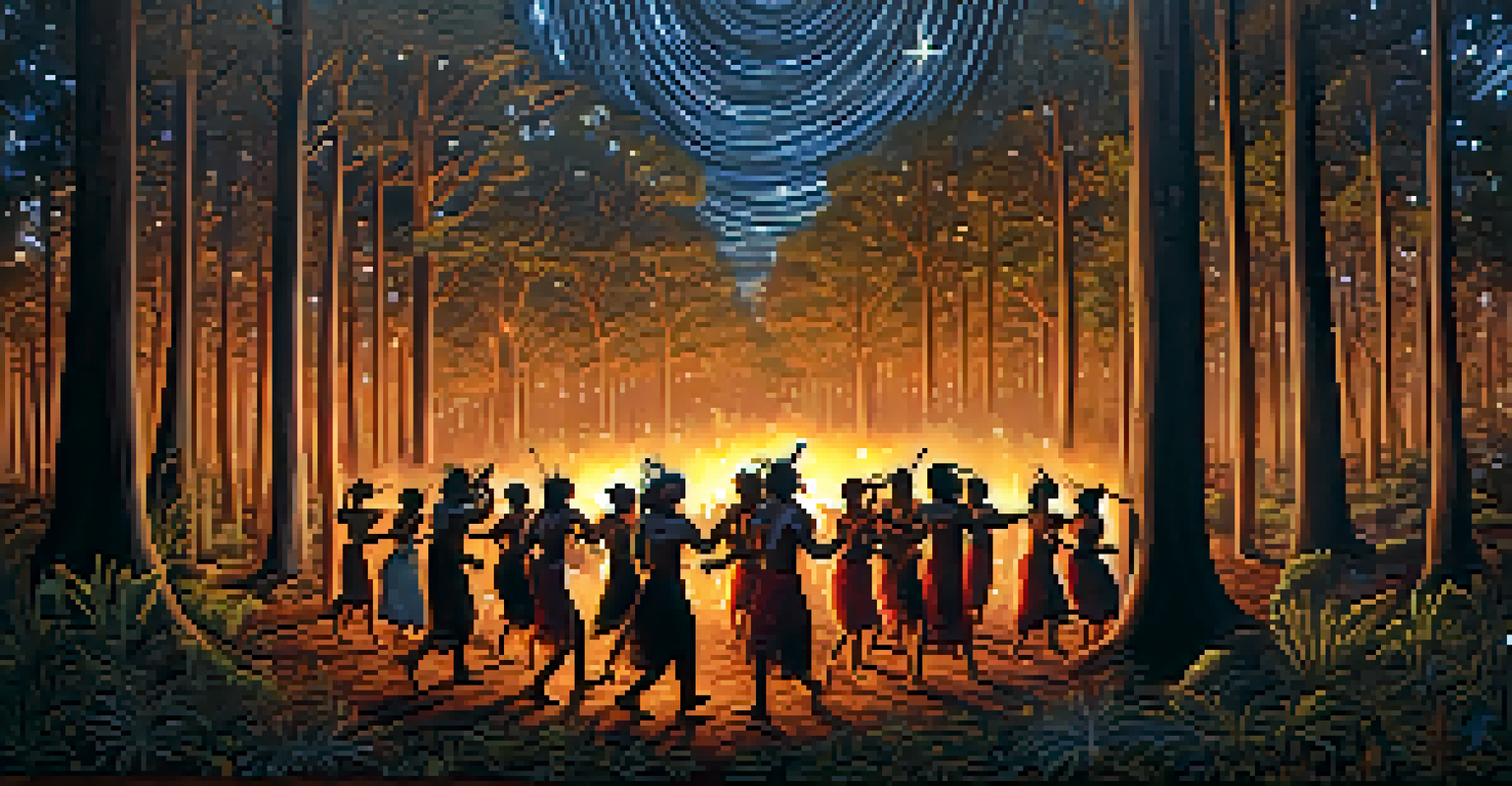Exploring the Ceremonial Dances of Indigenous Cultures

The Importance of Ceremonial Dances in Indigenous Cultures
Ceremonial dances play a vital role in Indigenous cultures, acting as a bridge between the spiritual and physical worlds. These dances often celebrate important life events, such as births, marriages, and seasonal changes. Through rhythm and movement, dancers express their connection to their heritage, ancestors, and the natural environment.
Dancing is the poetry of the foot.
For many Indigenous communities, these dances are not just performances; they are sacred rituals filled with stories and teachings. Each movement and song conveys deep cultural significance, often passed down through generations. This rich tradition helps to keep the community’s history and values alive in a fast-changing world.
Moreover, ceremonial dances foster a sense of belonging and unity among participants. They bring people together, reinforcing social bonds and collective identity. This communal aspect is essential, as it helps to nurture a supportive environment where cultural pride can flourish.
Types of Ceremonial Dances Across Different Cultures
Indigenous cultures around the world showcase a stunning variety of ceremonial dances, each with its unique characteristics and meanings. For instance, the Powwow in North America features vibrant regalia and competitive dance styles that honor tradition and community. In contrast, the Maori Haka from New Zealand combines powerful movements and chants to express strength and unity.

Similarly, the Aboriginal corroboree of Australia uses music and dance to tell stories and celebrate the connection to the land. Each type of dance serves a specific purpose—whether to welcome guests, mark transitions, or pay homage to the natural world. This diversity highlights the creativity and resilience of Indigenous cultures.
Ceremonial Dances Unite Communities
These dances foster social bonds and collective identity, enhancing cultural pride among participants.
Across the globe, these dances often share common themes, such as reverence for nature and the importance of community. However, the specific expressions and styles reflect the unique environments and histories of each culture. This rich tapestry of dance traditions underscores the significance of cultural expression in human experience.
The Role of Music in Ceremonial Dances
Music is an integral part of ceremonial dances, often serving as the heartbeat that drives the movement. Traditional instruments, such as drums, rattles, and flutes, create rhythms that guide dancers and evoke emotions. The choice of music can vary significantly, reflecting the specific purpose of the dance and the cultural context surrounding it.
The dance is a poem of which each movement is a word.
In many Indigenous cultures, the songs accompanying the dances are deeply spiritual, often telling stories of creation, ancestors, and life lessons. These melodies are not merely background; they enhance the overall experience and deepen the connection felt by participants. Even the songs' lyrics can hold powerful meanings, often invoking the spirits of the land and ancestors.
Moreover, the interaction between music and dance fosters a dynamic atmosphere where energy flows freely. This synergy allows dancers to express themselves fully, creating a mesmerizing spectacle that captivates both participants and audiences. The unity of music and movement is a testament to the rich cultural heritage that these ceremonial dances represent.
Ceremonial Dances as a Means of Storytelling
Storytelling is a powerful element of ceremonial dances, where every movement conveys a narrative. Dancers embody characters and events from their culture's history, allowing the audience to witness stories unfold through performance. This method of storytelling is particularly impactful, as it engages both the mind and the heart.
For example, in some Native American traditions, dancers might depict the journey of a hero or the relationship between humans and nature. Each gesture can symbolize different aspects of the tale, making the dance a living narrative that resonates with viewers. This mode of storytelling fosters greater understanding and appreciation for the culture being represented.
Dance as Cultural Storytelling
Ceremonial dances serve as powerful narratives that convey cultural histories and values through movement.
Additionally, these dances often serve as educational tools, teaching younger generations about their heritage. By participating in or watching these performances, individuals can learn vital lessons about their identity, values, and responsibilities to their community. Thus, ceremonial dances preserve and pass down cultural knowledge in a powerful and engaging way.
The Spiritual Significance of Ceremonial Dances
Many Indigenous ceremonial dances are deeply spiritual, connecting participants to the divine and the universe. These dances often invoke spirits, ask for blessings, or express gratitude for the gifts of life. This spiritual dimension adds a layer of meaning that transcends the physical performance, making it a profound experience for those involved.
For instance, the Sun Dance of the Lakota people is a sacred ceremony that includes dance, fasting, and prayer, aimed at seeking spiritual renewal and community healing. This powerful ritual exemplifies how dance can be a form of devotion, allowing participants to express their faith and seek deeper connections with the spiritual world.
Moreover, the act of dancing itself can be seen as a form of meditation, providing a space for reflection, healing, and personal growth. The rhythmic movements and communal energy create an atmosphere where participants can connect with their inner selves and the collective spirit of their community. This spiritual aspect of ceremonial dances is a crucial element of their enduring significance.
Preservation and Evolution of Indigenous Dance Traditions
As with many cultural practices, Indigenous dance traditions face challenges in preservation amid globalization and modernization. Yet, communities are finding innovative ways to keep their ceremonial dances alive, often incorporating contemporary elements while honoring traditional roots. This evolution ensures that their cultural expressions remain relevant for future generations.
For example, some Indigenous artists are blending traditional dance with modern music and performance styles, creating hybrid forms that resonate with younger audiences. This approach not only attracts new participants but also fosters a greater appreciation for the richness of Indigenous cultures. By adapting to changing times, these communities are ensuring their traditions continue to thrive.
Spiritual Connections Through Dance
Many Indigenous dances have deep spiritual significance, allowing participants to connect with the divine and their heritage.
Furthermore, educational initiatives and cultural exchanges have played a significant role in raising awareness about Indigenous dance. Workshops, festivals, and collaborations with non-Indigenous artists help to promote understanding and respect for these traditions. This ongoing dialogue is essential for preserving the integrity of ceremonial dances while allowing them to evolve naturally.
The Impact of Ceremonial Dances on Community Identity
Ceremonial dances serve as a powerful expression of community identity, reinforcing cultural pride and shared values. When members of a community come together to participate in these dances, they create a strong sense of belonging and solidarity. This collective experience fosters a deeper connection to their heritage and to each other.
In many cases, these dances also serve as a declaration of resilience against external pressures that threaten cultural erasure. By showcasing their unique traditions, Indigenous communities assert their identity and claim their place in the world. This act of cultural expression can be both empowering and healing, helping to affirm a positive self-image.

Moreover, the intergenerational aspect of ceremonial dances ensures that cultural knowledge is passed down, creating a legacy of identity for future generations. As young people learn the dances and the stories behind them, they internalize their culture's values and teachings. This ongoing cycle of learning and participation strengthens the community's identity, ensuring that it remains vibrant and dynamic.